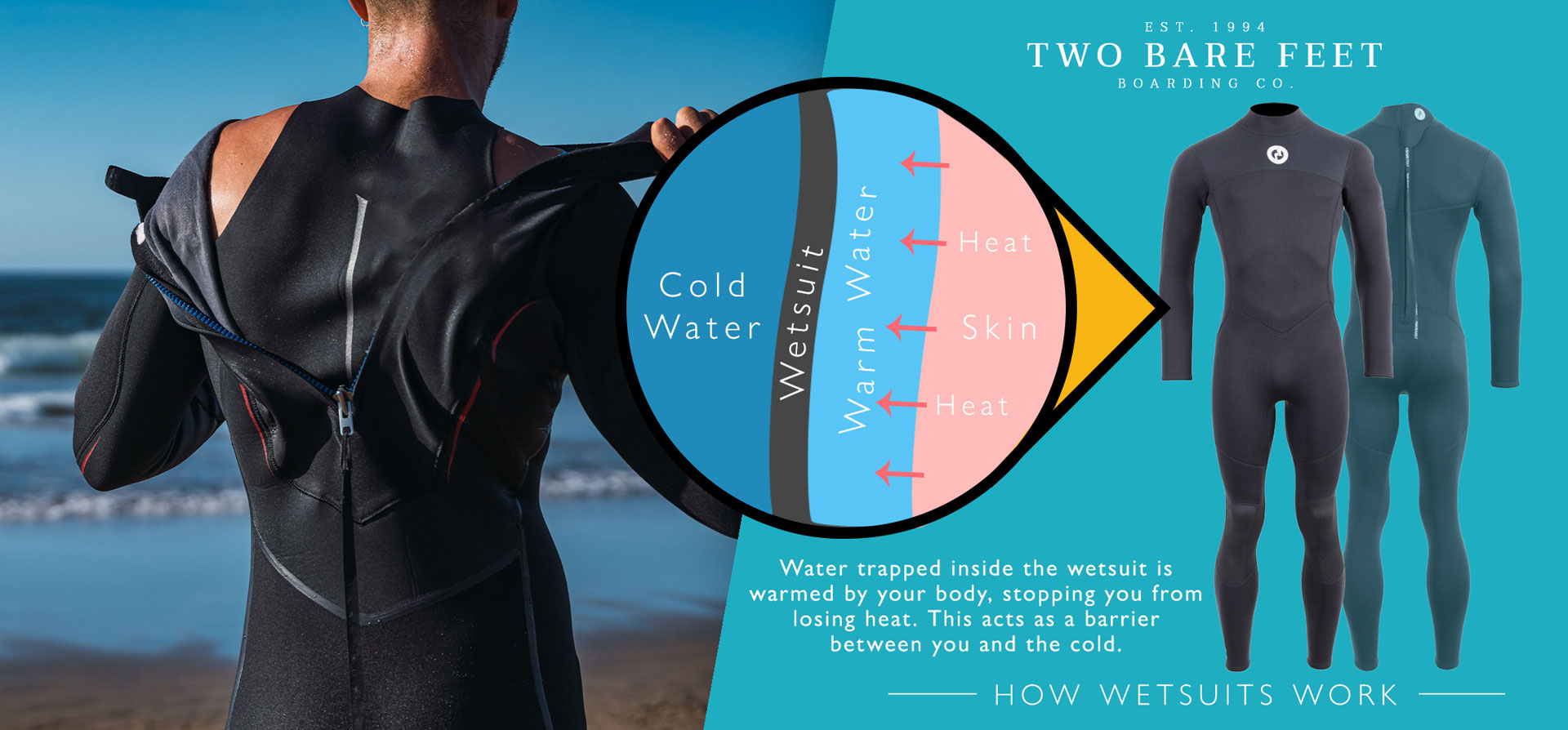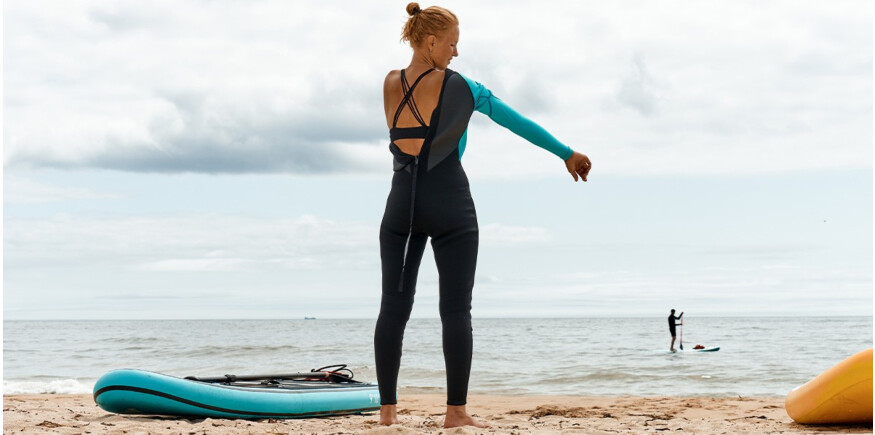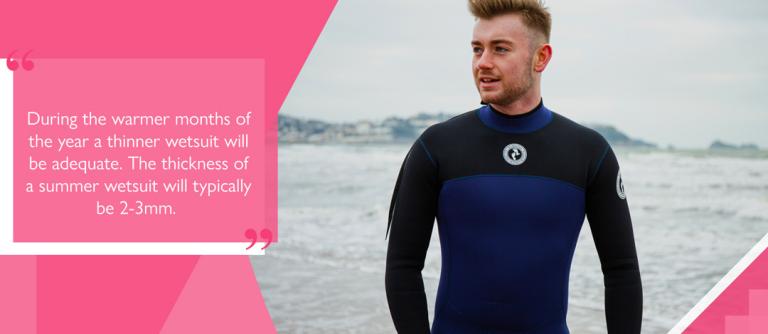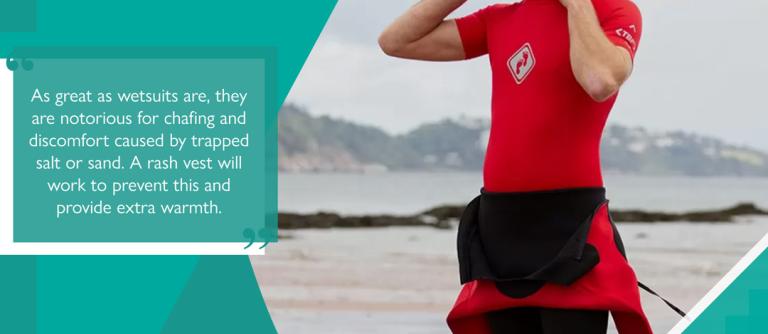Anyone who’s ventured into the UK’s chilly waters in just a swimming costume understands the benefits of a wetsuit. Guaranteed to keep you warm no matter what the elements throw at you, a high-quality wetsuit is essential kit.
However, as useful as they are, they can be tricky to buy correctly. What’s the right size? What do the numbers mean? What do different types of stitches do?
Wetsuit shopping can be a minefield, with many people getting it wrong. Unfortunately, wearing a poorly fitting wetsuit – especially when constructed from low-quality materials – will dampen your experience in the water.
With this in mind, we have put together a comprehensive wetsuit-buying guide – aimed at helping you find the perfect wetsuit.


.
How do wetsuits work?
Before buying your wetsuit, we need to know how they work. A neoprene wetsuit provides effective insulation by trapping a thin layer of water between the material and your skin – not by keeping you dry.
The water trapped inside the wetsuit is warmed by your body, stopping you from losing heat and keeping you warmer for longer.
Because of the way a wetsuit works, choosing a wetsuit which fits well is key to its effectiveness. If the suit is too big, water will continuously flush in and out which prevents a layer of water insulation from forming.
Wetsuit thicknesses explained.
If you’ve already begun the search for a new suit, you will have noticed the unusual thickness measurements. Normally consisting of two or three numbers, separated by forward slashes, the figures refer to the thickness of the neoprene across different parts of the body, as measured in millimetres.
The first number denotes the thickness of the torso material; the second relates to arm and leg thickness. For example, a wetsuit described as 4/3mm has 4 mm neoprene across the body, and 3mm across both the arms and legs. For wetsuits with three measurements, the first refers to the torso; the second relates to the legs; the third is the thickness across the arms.
High-quality neoprene wetsuits offer a variation of thicknesses to ensure you stay warm without compromising wetsuit manoeuvrability. Thinner material around the extremities allows the range of movement needed for sports such as paddleboarding, with thickness focused on the bulk of the body to ensure heat is retained.
But which thickness is right for me?
Now you know how wetsuit measurements are conveyed – but which levels of thickness do you need? Optimum thickness will depend largely on when you are planning to venture into the water.
During the warmer months of the year a summer wetsuit will be adequate. The thickness of a summer wetsuit will typically be 2-3mm. If you’re brave enough to take a dip during cooler weather, you will need some additional protection – especially in the UK. Wetsuits with a thickness of about 4mm are suitable for transitional seasons, while a winter wetsuit will be 5-6mm thick.
.
Wetsuit buying guide: other alternative cuts
Your wetsuit search may have also presented you with a selection of shorty suits, as well as other alternative cuts. Although less popular than a standard full wetsuit, these variants have their uses. We’ve broken down a few of these suits below to help guide your decision and understand whether they’re right for you.
Shorty wetsuits
The second most popular type of wetsuit, a shorty wetsuit is often favoured by swimmers who head into the water during the summer, as they naturally provide less insulation. Less restriction makes a shorty perfect for those of you planning on partaking in demanding water sports such as kayaking or paddleboarding. We’d also recommend a shorty suit for kids, as they tend to be easier to get in and out of.
Two-piece wetsuits
A two-piece wetsuit set is comprised of a separate jacket and shorts, in either a full-length or shorty style. Although separates do not offer the same level of insulation as an all-in-one suit due to water flushing more easily, they are amazing for flexibility and comfort.
Sleeveless wetsuits
A sleeveless wetsuit, with no arms and long legs, is designed to be worn for water sports that require plenty of arm movement, such as kayaking or a triathlon. Unrestricted movement of your arms means you can continue paddling for longer without tiring.
Hooded wetsuits
If you’re planning on staying in the water for an extended period or will be diving below the surface, a hooded wetsuit is highly recommended. We lose most of our body heat via the head; keeping it insulated will ensure you stay warmer for longer. This is first and foremost a safety precaution but will also help to maximise your enjoyment of the experience. Check out our in-depth guide on how to choose the best wetsuit for diving.
Wetsuit buying guide: zips.
Another feature to consider when buying a wetsuit is its zip. A quality zip can be the make or break as to how effective your suit is at keeping you warm. A broken zip will allow water to flush in and out easily, preventing proper insulation.
A back zip runs the whole length of the back allowing the suit to open further and making it easier to get in and out of.
A wetsuit with a front zip is easier to get into alone, but some wearers find having the zip closure at the front of their neck slightly irritating.
Deciding which zip is best for you is based on personal preference. At Two Bare Feet, we offer the choice between the classic back zip or a front zipper on our wetsuit jackets.
.
Wetsuit seams and stitching
When buying a wetsuit, it’s vital to inspect the type of seam/stitch it possesses. As it’s the point where each section of neoprene meets, a poor stitch will prevent insulation.
The most basic type of seam is the overlock stitch, which essentially rolls two edges of material together and stitches them. Not only will this create an irritating bulge on the inside of your suit, it is also regarded as the least reliable type of seam – prone to wear and not watertight. This type of seam is usually found on lower-quality wetsuits.
At Two Bare Feet, you’ll find that all our wetsuits boast a reliable flatlock stitch, whereby the neoprene panels are slightly overlapped. Not only does a flatlock stitch reduce any irritation caused by a protruding seam, it also successfully prevents water penetration, keeping you warmer for longer.
.
Wetsuit buying guide: accessories
Buying a wetsuit is only one part of the solution. Depending on your plans, you may also want to equip yourself with some extras. While you don’t need to invest in every type of accessory, some add-ons are essential.
Rash vests
No matter where you’re heading or what exciting activities you’ve got planned, we would always recommend complimenting your wetsuit with a rash vest. As great as wetsuits are, they are notorious for chafing and discomfort caused by trapped salt or sand. A rash vest will work to prevent this and provide extra warmth.
If you’re heading to a particularly cold destination, or getting in the water during the winter, a thermal rash vest will undoubtedly become your new best friend.
Wetsuit hoods
Similarly to a hooded wetsuit, a separate hood is designed to stop heat escaping via your head, provide extra insulation, and prevent the onset of surfer’s ear – a condition which can affect hearing if the ears are exposed to cold wind and water.
Usually made of neoprene, hoods are best for those venturing into colder waters or who love the thrill of diving. Many people prefer a separate hood to a hooded wetsuit: it makes their setup more versatile and less restrictive.
Wetsuit boots
A pair of wetsuit boots serves three purposes: grip, warmth, and protection. In the water, your extremities are often the first to feel the cold, and your feet tend to be in the water the most. Wetsuit boots and socks will keep your feet warm by providing extra insulation and protecting your feet from unseen underwater hazards.
Wetsuit experts
Here at Two Bare Feet we pride ourselves on being wetsuit specialists. If you’re still unsure of the best wetsuit for you, please don’t hesitate to get in touch – our helpful team will be more than happy to assist.
Check out how to store your new wetsuit or alternatively, head over to our wetsuit size guide to determine your perfect fit.






